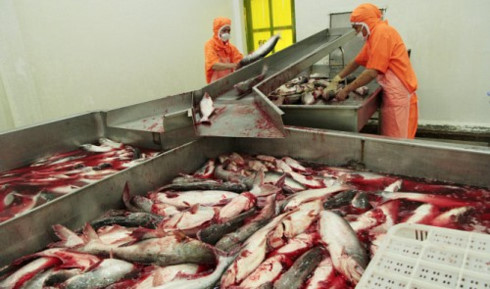Vietnam catfish exporters worry as US applies tougher inspection procedures
- Phu Yen fishermen catch rare bluefin tuna in Hoang Sa
- Vietnam works to stop fishermen violating other countries’ EEZ
- Vinastas asked to clarify personal faults in last year’s fish sauce case
- Twenty tortured, then murdered in Pakistan Sufi shrine
From August 2, all Vietnamese catfish shipments to the U.S. must be transferred to official import inspection establishments specified by the U.S. Food Safety and Inspection Service (FSIS) for re-inspection before they can be forwarded to importers and sold to American end-consumers.
The requirement is part of a series of new regulations stipulated by the U.S. farm bill, or the Agricultural Act of 2014, that was signed into law on February 7, 2014.
 |
| Vietnam catfish exporters worry as US applies tougher inspection procedures. |
One of the biggest changes in the bill is that Vietnamese seafood entering the U.S. will be required to follow regulations set forth by the FSIS under the U.S. Department of Agriculture, rather than the U.S. Food and Drug Administration (FDA), as was previously the case.
The food safety standard regulated by the FSIS is a big change from the standards applied by the FDA and may take Vietnam many years to adapt to, according to the Vietnam Association of Seafood Exporters and Processors (VASEP).
For instance, according to a 2016 report, the FSIS will require a review of 100 percent of imported products starting September 2017, instead of the only one percent required by the FDA.
Truong Dinh Hoe, VASEP general secretary, told Tuoi Tre (Youth) newspaper earlier this week that the new requirement that catfish exports be re-inspected before delivery to importers to the U.S. will negatively impact Vietnamese exporters.
“It is certain that Vietnamese companies will have to spend more time and money transporting the shipments to the FSIS-specified warehouses and then to their own facilities,” Hoe said.
Duong Ngoc Minh, general director of Hung Vuong, one of Vietnam’s leading catfish exporters to the U.S., concurred with Hoe’s concern, explaining that following the new rule will cost both time and money.
“There are only a little more than 20 warehouses on the FSIS list, which are located across the U.S. and may not be close to seaports where the Vietnamese catfish shipments arrive,” he explained.
Vietnamese seafood businesses are losing sleep over the higher and tougher technical barriers set by the U.S., as the North American country is their largest catfish importer.
Reassurance
However, according to Hoe, the VASEP general secretary, while it cannot be denied that the threat is real, the future is not as gloomy as businesses might think.
“It is unreasonable to say that these new rules will shut the door on Vietnamese catfish entering the U.S.,” Hoe said.
The VASEP official explained that these policy changes were announced well in advance to affected businesses, and Vietnamese exporters did have a window of preparation for the new rules.
Vietnamese businesses and relevant authorities have indeed made moves to embrace the changes, he added.
“Exporters only need to ensure the quality of their products and everything will go on as normal,” he said.
“You have to pass strict inspections no matter which countries you sell your goods to.”
Hoe also rectified allegations that 100 percent of Vietnamese seafood exports to the U.S. will be taken for sample testing.
“The ratio of samples to be taken depends on the inspection history of the exporters,” he said.
“Since the oversight task was transferred to the USDA from the FDA, the ratios were increased to only 20-30 percent, and never 100 percent.
“There will be no such rule as 100 percent of exports must be inspected as Vietnamese businesses fear.”
Minh, the Hung Vuong Co. executive, also said the future is not so bleak.
“Even before the U.S. enacted these new regulations, most Vietnamese seafood exporters still failed to sell their catfish to the market,” Minh said.
There are currently only three Vietnamese companies qualified to export catfish to the U.S. under low anti-dumping duties, while other businesses are slapped with exorbitant tariffs and unable to afford shipping to the U.S.

